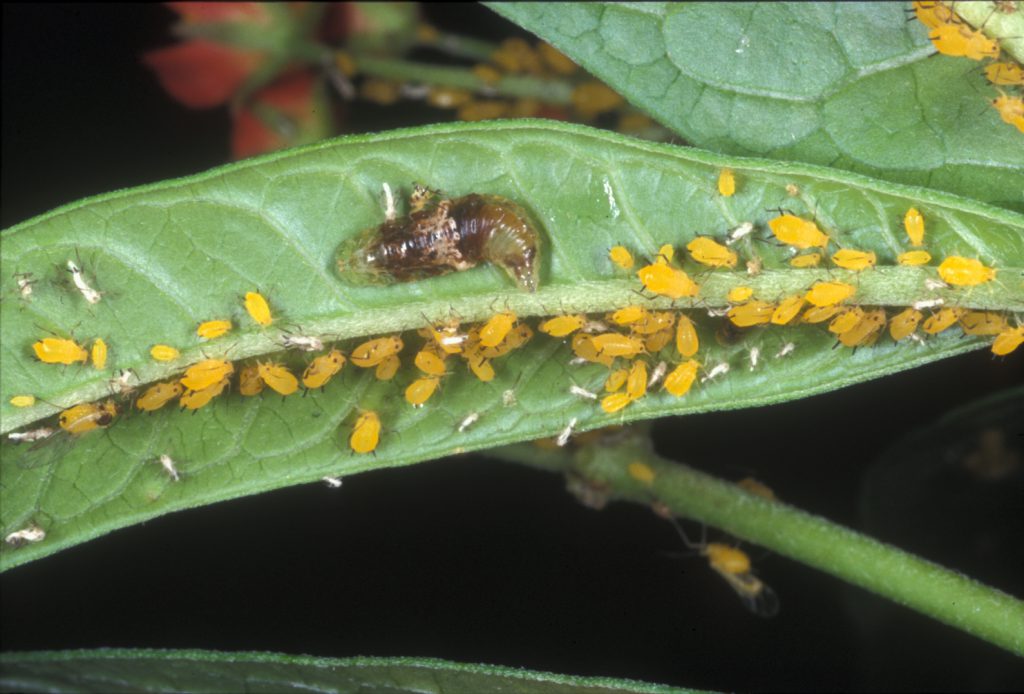
When we think of pests we tend to focus mainly on insects. Insects make up roughly 80% of animal life, however only about one percent of insects are considered pests. The rest help pollinate crops, kill pests, clean up dead stuff, and make honey. Unfortunately, plants suffer from many more types of pests such as weeds, disease, and us. This episode of “Gardening in the Panhandle LIVE!” was all about managing pests.
Many soft-bodied insect pests can be controlled with insecticidal soap. Many insecticidal soaps are on the market that can help control pests like aphids and whiteflies. However, dish soaps are manufactured for cleaning dishes and not labeled for pest control. More information on insecticidal soaps can be found in the publication “Managing Plant Pests with Soaps”.
Although dish soap isn’t a good option for insect control, there are some things from around the house that can be used to help manage pests. The publication “Do-It-Yourself Insect Pest Traps” offers some excellent options for monitoring and managing pests with traps.
Florida is home to a plethora of insect pests. The Ask IFAS website has many articles on insect pests common in the garden.
Companion planting is the practice of planting two or more plant species close to each other to improve growth and/or pest control of one or more of the species. The article “Companion Planting: What is it?” offers some great recommendations and examples of this technique. Marigolds are an excellent companion plant because they can help deter and suppress nematode populations.
Some people prefer to only use naturally derived products for pest control. The publication “Natural Products for Landscape and Garden Pests in Florida” extensively reviews some of these products. Bacillus thuringiensis (BT) is a bacteria found in soil that can be used for caterpillar pest control.
We love our squash, cucumbers, and watermelons in the South, however there are a number of insects that like to eat them too. More information on cucurbit insect pests and their management can be found in the publication “Insect Management for Cucurbits”.
Armyworms like to feed on just about everything. The Ask IFAS website has a nice collection of publications on all types of armyworms.
Some fungi are fun to eat while others kill our landscape plants. One common fungal disease found in the landscape is Entomosporium leaf spot. This disease is very common on Indian hawthorns. The article “Keep an Eye on Your Indian Hawthorn” describes this disease and it’s control.
Aphids are a very common insect pest. In fact, some plant species have specific aphids. More information on different aphid species and their control can be found in the publication “Aphids on Landscape Plants”.
A plant in the wrong place is considered a weed. Some plants are particularly good at finding the wrong place and can take over our lawns. The publication “Weed Management Guide for Florida Lawns” offers solutions on controlling common lawn weeds.
Ticks can be pests of pets, livestock, and humans. Texas A&M has created an excellent website on everything about ticks.
Cockroaches do a nice job cleaning up litter when they’re outside, but we don’t need want them in our houses whether they’re cleaning up trash or not. The publication “Cockroaches and Their Management” is a great resource for cockroach species identification and management.
As previously mentioned, there are a lot more good insects than bad insects. For more information on predatory insects and biological controls check out the publication “Natural Enemies and Biological Control”.
Nature is fascinating and most people are lifetime learners. To help find out what you’re looking at, give the iNaturalist website and app a try.
Armadillos don’t mean any harm and can be kind of cute. However, they can make a mess of our yard and they build their dens in some undesirable locations. The publication “The Nine-Banded Armadillo” provides information on armadillos and their management.
Fire ants are pests of our lawns and pastures and their sting is brutal. For more information on fire ants please refer to the publication “Managing Imported Fire Ants in Urban Areas”.
Pests can be pesky, but they are manageable if you keep up with the art and science of their control. If you need help with identification and pest management options please don’t hesitate to contact your local Extension Office.
Past episodes of Gardening in the Panhandle LIVE can be found on our YouTube playlist.
- Gardening in the Panhandle LIVE! Program Summary: Pests of Florida Lawns and Landscape Plants - May 28, 2025
- Fun Facts About Ferns - April 30, 2025
- Gardening in the Panhandle LIVE! Program Summary: Freeze Friendly Foliage Plants - April 30, 2025
